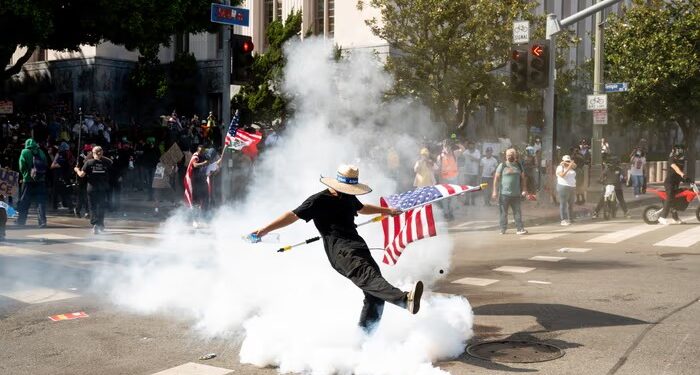Widespread protests erupted across major US cities following the conclusion of former President Donald Trump’s highly controversial military parade, held in Washington D.C. over the weekend. The event, which featured tanks rolling down Constitution Avenue and flyovers by combat aircraft, drew both large crowds of supporters and waves of criticism from opponents who labelled it a dangerous display of authoritarianism.
The parade, titled “American Power”, marked the anniversary of Trump’s initial 2019 military spectacle and was meant to showcase what organisers called “the enduring strength of the American spirit and military might.” However, it has sharply divided public opinion and drawn condemnation from civil rights groups, Democratic politicians, and even several veterans’ organisations.
Within hours of the parade’s conclusion, coordinated protests broke out in New York, Chicago, Los Angeles, Atlanta, and Philadelphia. Demonstrators marched through central districts chanting slogans such as “No tanks in our streets,” “Democracy not display,” and “Resist fascism.” In Washington itself, protesters clashed with police near the Capitol Building as barricades were set up to contain demonstrator access. Several arrests were made, though no fatalities or serious injuries were reported.

“This isn’t patriotism, it’s a propaganda show,” said Marlene Cruz, a protest organiser in Los Angeles. “We’re witnessing the slow militarisation of civic life, and that’s terrifying.”
The military parade also reignited fears about the politicisation of the armed forces. Though officially sanctioned as a civilian event, the parade featured current military personnel saluting Trump, who has remained a polarising figure since leaving office. Critics argue this blurs the constitutional boundary between the military and civilian government, undermining democratic norms.
Trump, speaking at the close of the parade from a specially constructed podium near the Lincoln Memorial, called the event “a tribute to the brave men and women who make America great.” He also repeated themes from his 2024 campaign, hinting at a return to office and lambasting the Biden administration’s “globalist weakness.”
Political analysts note that the parade’s symbolism fits squarely within Trump’s broader attempt to reassert his presence in national discourse ahead of the upcoming election cycle. “This is Trump’s way of projecting strength,” said Professor Lila Hart of Columbia University. “But it’s also a warning—an authoritarian signal wrapped in patriotic branding.”
Reaction among military veterans has been mixed. While some praised the focus on service members, others expressed concern that the parade compromised the military’s apolitical image. Retired Marine Colonel James O’Hare told reporters, “There’s a time to honour service, but this felt more like a campaign rally in uniform.”
Meanwhile, the Department of Defense remained notably silent on the event, issuing no formal comment. White House officials distanced President Biden from the parade, stating it was not an official federal initiative and reiterating the administration’s support for peaceful public assembly.
As the dust settles on the streets and debate rages across media platforms, the event has once again highlighted the deep ideological divide in American society. With election rhetoric heating up and Trump continuing to command a loyal base, analysts warn that further polarisation—and public unrest—may follow in the months ahead.
newshub finance



Recent Comments